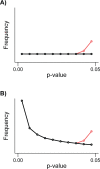The extent and consequences of p-hacking in science
- PMID: 25768323
- PMCID: PMC4359000
- DOI: 10.1371/journal.pbio.1002106
The extent and consequences of p-hacking in science
Abstract
A focus on novel, confirmatory, and statistically significant results leads to substantial bias in the scientific literature. One type of bias, known as "p-hacking," occurs when researchers collect or select data or statistical analyses until nonsignificant results become significant. Here, we use text-mining to demonstrate that p-hacking is widespread throughout science. We then illustrate how one can test for p-hacking when performing a meta-analysis and show that, while p-hacking is probably common, its effect seems to be weak relative to the real effect sizes being measured. This result suggests that p-hacking probably does not drastically alter scientific consensuses drawn from meta-analyses.
Conflict of interest statement
The authors have declared that no competing interests exist.
Figures




Comment in
-
Commentary: The Extent and Consequences of P-Hacking in Science.Front Psychol. 2020 Sep 30;11:581910. doi: 10.3389/fpsyg.2020.581910. eCollection 2020. Front Psychol. 2020. PMID: 33101152 Free PMC article. No abstract available.
References
-
- Begg CB, Berlin JA (1988) Publication bias—a problem in interpreting medical data. J R Stat Soc Ser A Stat Soc 151: 419–463.
Publication types
MeSH terms
LinkOut - more resources
Full Text Sources
Other Literature Sources

